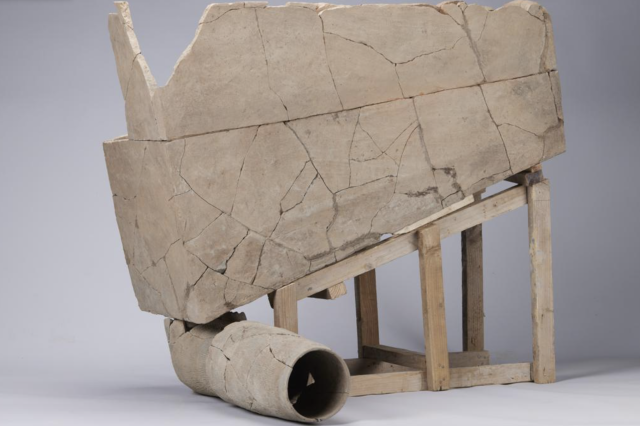Xbox 220 BC.
Archaeologists have recently excavated a mysterious x-shaped tomb in China. The tomb’s surface has revealed an eerie similarity to, guess what? The Xbox. The image of the discovered Chinese tomb was posted on Twitter and drew thousands of users’ attention due to the structure’s similarity with the Xbox Console logo.

The image of the tomb was eventually picked up by the official Xbox Twitter account, joking: “Oh yes, that’s the Xbox 220 BC.”
Ah yes, that's the Xbox 220 BC.
— Xbox (@Xbox) January 7, 2019
An Unexpected Tomb Discovery
When a tomb dating back to China’s Qin Dynasty (221 BC-206 BC) was first discovered, many initially believed it to be a hoax or a marketing ploy. However, contrary to these initial suspicions, the tomb’s authenticity has been confirmed, shedding new light on this fascinating period of Chinese history. Further details about this remarkable find can be found in a video posted by CCTV10 on their official Weibo account.
The Genuine Nature of the Qin Dynasty Tomb
Despite the initial doubts surrounding the tomb’s legitimacy, experts have since verified its authenticity, confirming that it is indeed a genuine relic from the Qin Dynasty. This extraordinary discovery offers an invaluable opportunity for researchers to gain a deeper understanding of this influential period in Chinese history and the customs and practices surrounding burial during the Qin Dynasty.
Exploring the Discovery through CCTV10’s Weibo Video
To learn more about the discovery and the ongoing excavation of the Qin Dynasty tomb, interested individuals can turn to the CCTV10 Weibo account, which has posted a video detailing the findings. The video provides a captivating glimpse into the tomb, offering a visual testament to its authenticity and the significance of this remarkable historical find.
The First Imperial Dynasty of China
The Qin Dynasty (221-206 BCE) was the first imperial dynasty of China, founded by Qin Shi Huang, who united the warring states after centuries of conflict. Although the Qin Dynasty was short-lived, it had a significant impact on Chinese history, setting the stage for the imperial system that would dominate the country for the next two millennia.
Centralization and Legalism: The Cornerstones of Qin Rule
The Qin Dynasty was characterized by centralization and the implementation of a strict legalist system. Qin Shi Huang abolished the previous feudal system and divided China into 36 commanderies, each governed by a centrally-appointed official. This centralized administration allowed the emperor to maintain control and implement policies across the vast empire.
Legalism, a political philosophy that prioritized strict laws and severe punishments, was the foundation of Qin governance. This system aimed to maintain order and control, with the belief that people were inherently selfish and required strict regulation to maintain harmony in society.
The Great Wall and Infrastructure Development
One of the most well-known achievements of the Qin Dynasty was the construction of the Great Wall of China. The Great Wall was built to protect the empire from northern invaders, and although it was not completed during the Qin Dynasty, the project laid the groundwork for the monumental structure we know today.
The Qin Dynasty also invested in infrastructure development, such as the construction of roads, canals, and irrigation systems. These projects facilitated trade, transportation, and communication within the empire, strengthening the economy and improving the lives of the people.
The Legacy of the Qin Dynasty: Cultural Unification and the Terracotta Army
The Qin Dynasty left a lasting cultural legacy, as Qin Shi Huang implemented standardization of the Chinese writing system, currency, and weights and measures. This cultural unification played a significant role in fostering a shared identity among the Chinese people and contributed to the longevity of China’s imperial system.
One of the most famous archaeological discoveries related to the Qin Dynasty is the Terracotta Army, a massive collection of life-sized terracotta sculptures depicting the armies of Qin Shi Huang. These sculptures were buried with the emperor to protect him in the afterlife and serve as a testament to the grandeur of the Qin Dynasty.
A Pivotal Period in Chinese History
Despite its brief existence, the Qin Dynasty left an indelible mark on Chinese history. Its centralized administration, legalist principles, and cultural unification laid the groundwork for China’s imperial system, which would last for more than 2,000 years. The Qin Dynasty’s influence can still be seen today, with its most enduring symbol, the Great Wall of China, standing as a testament to the empire’s ambition and legacy.
PLEASE READ: Have something to add? Visit Curiosmos on Facebook. Join the discussion in our mobile Telegram group. Also, follow us on Google News. Interesting in history, mysteries, and more? Visit Ancient Library’s Telegram group and become part of an exclusive group.





